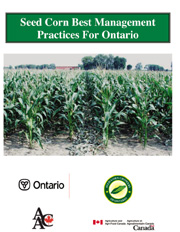
News
Food grade soybeans forging new path
Trying to decouple pricing from CBoT.
November 14, 2007 By Top Crop Manager
 Although the food grade soybean sector has a well-earned reputation for its
Although the food grade soybean sector has a well-earned reputation for its
quality and integrity, Canadian representatives are pushing for a new grading
structure. The new grade might establish a higher premium by separating from
the current base price for conventional soybeans established by the Chicago
Board of Trade (CBoT), which then has a premium paid by a buyer. The new structure
also would recognize Canadian growers and their ability to consistently meet
quality standards they have helped create in the past 10 to 15 years.
Roger Rivest, marketer for Great Lakes Organics in Petrolia, Ontario, finds
the disparity between gradings in Canada and those in other countries particularly
frustrating. What often ranks as a Food Grade Two in Canada is another country's
Food Grade One, yet Canadian growers can be discounted, despite a higher overall
quality standard. "It's causing us some problems for our exports,"
says Rivest. "I've been saying this for three years that I want buyers
to look at this as food and not a commodity, and start treating it as such,
and decouple it from the CBoT."
The timing for this development could not be better. Higher corn prices resulting
from an expected increase in demand for ethanol are purported to be driving
several trends in the coming months. It is believed that an IP system for corn
will begin to take shape in light of the demand for specific traits and properties
among those in the ethanol industry. More important to Rivest, however, is an
anticipated struggle which could develop as food, feed and fuel sectors vie
for their share of raw materials. Such demands may actually push up prices as
processors and manufacturers try to secure their supply lines.
In that setting, Rivest's goal of establishing a food grade pricing structure
might have a greater chance of success. "That's something we're going to
discuss and develop over the next two years," he says. "From there,
I'm hoping to do a separate pricing issue and decouple it from the CBoT."
Not a quick process to affect change
Admittedly, the process to undergo such change is a difficult one. Not only
is the CBoT the standard for pricing, the IP food grade sector in the US is
not on firm ground to impose changes on the establishment.
Then there is the situation in Canada. According to Jim Lowe, regional director
with the Canadian Grain Commission's Chatham, Ontario office, although changing
the pricing structure on food grade soybeans may be warranted, it must come
from inside the industry and that is a long, drawn-out process.
Currently, there is no grading system in place for food grade soybeans. The
Eastern Grain Standards Committee, defined and operated under the Canada Grains
Act, assesses and makes recommendations about how grades and quality are determined.
"So far, the Canadian Soybean Export Association has asked the Standards
Committee to consider a change to allow a food grade specific system and pull
it out of the current system," explains Lowe. In its current single grade
system, both food grade interests and crushers apply the same criteria. "What
they're looking at is developing something like a 'One Canada Food Grade' or
a 'One Canada Special Quality' to reflect the food side of it."
It is simply a recognition of the end-use properties, not just the process
of production. "An IP program would be set-up to provide an end user with,
let's say, only one variety, but the quality system would be on top of that,
saying 'Okay, this is the variety and this is the quality of the shipment you're
getting'," explains Lowe.
Eventually, decoupling the pricing structure away from the CBoT would help
agriculture evolve towards a level of assurance the industry has been talking
about for years. End users who are content to purchase conventional or even
genetically modified soybeans can expect base pricing since there is little
or no specialization involved. However, as Lowe explains, if a soybean comes
with a trait that people recognize as an advantage and demand only that soybean,
then processes must be put in place at the farm level that are going to achieve
that goal.
"That will all cost money so somebody's going to have to pay for that,"
he says. "If a grower can provide that to a processor, and they want it
over a long time, then they have to be prepared to recognize it. If you want
CBoT beans, there are no guarantees, and if you want guarantees, there has to
be some extra money in it." -30-